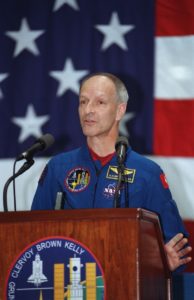Artist’s view of Vega VV16 with SSMS © Esa
Swiss start-up ClearSpace SA has signed a service contract with the European Space Agency (ESA) worth 86.2 million euros to remove orbital debris. This mission, named ClearSpace-1, will see the first debris removed by 2025.
ClearSpace SA – a spin-off of EPFL, created in 2018 by space debris experts – was selected out of twelve other candidates to develop ClearSpace-1, an innovative service to remove space debris from orbit. ClearSpace-1 aims to develop sustainable technology to clean space as well as provide other services in orbit to support a new sustainable space economy.
“We are delighted that ESA has put their faith in us. We share the same clear vision of safer, more sustainable space for all, that is our goal,” says Luc Piguet, co-founder and CEO of ClearSpace. “The way space has been used until now has led to a situation where over 5,000 satellites and out-of-control rocket stages are in orbit compared to only 2,700 working satellites. In-orbit services are not only a natural part of future space operations, they will also ensure the development of a thriving space economy.”

Over the past ten years, the number of satellites launched every year has increased tenfold to over 600 a year. At the same time, the rising amount of debris in space is a growing threat to the future and safety of space activity. Over 23,000 items of debris closely tracked.
“Drawing on its experts, engineers, researchers and network of industry specialists throughout the world, ClearSpace is building technology that will enable space debris to be removed safely and sustainably. It has put together its team of subcontractors and has already started design and testing work. Over the next few years, advanced technology will be developed and integrated in the spacecraft to be launched in early 2025,” explains Muriel Richard-Noca, co-founder and head engineer at ClearSpace.
FIRST AUTONOMOUS MISSION TO REMOVE SPACE DEBRIS SET FOR 2025
ClearSpace-1’s mission is to develop a robot-like spacecraft with four articulated arms which will ultimately enable space debris to be removed safely. ClearSpace-1’s first task scheduled for 2025 after launching from the Kourou space centre in French Guiana, will be to bring down the Vespa (Vega Secondary Payload Adapter) left by the Vega rocket placed in orbit in 2013, the size of a 112 kg satellite. With its articulated arms, the robot will remove Vespa and move it closer to the earth’s atmosphere where it will burn up and disintegrate.
ClearSpace-1 is part of ESA’s ADRIOS programme to develop in-orbit services for satellites such as refueling, repairs and orbital manoeuvres.
The Swiss start-up will need to draw on its network of sponsors and contributors to help fund this 14-million-euro project, representing 14% of the total project cost which stands at circa 100 million euros to which ESA contributes 86 million euros. This investment will create high added-value employment locally and launch a new in-orbit cleaning market which is set to thrive in the years to come.

CLEARSPACE A VENTURE HARNESSING INDUSTRY AND RESEARCH TALENT FOR SPACE
ClearSpace is in charge of Research & Development, designing and building the spacecraft with the help of its industry partners.
Four companies will provide ClearSpace SA with systems engineering expertise:
- Deimos Portugal and UK will be responsible for the navigation and guidance systems.
- Airbus in Germany will be in charge of avionic assembly based on Airbus’s flexible LEO platform (FLP2), adapted for robots.
- OHB-Sweden will design and manufacture the propulsion system which will give the space robot the maneuverability it requires. OHB-Sweden is also foreseen to be in charge of final integration of the satellite on their premises and all related tests.
- APCO-Technologies in Switzerland will offer its expertise in satellite structure and thermal control. It will be responsible for designing, developing and testing the systems required to ensure the robot survives the launch and subsequent space environment.
- Satellite Applications Catapult is an essential partner for setting up the operations centre. It will be joined by several British companies, currently being assessed, to develop, test and approve the mission software on the ground.
A group of Swiss industry sponsors including RUAG Space, Syderal Swiss Micro-Cameras & Space Exploration and nanoSPACE will also contribute to the project in their respective fields. They will be joined by cutting-edge space industry researchers and academics such as EPFL, scientists at the HEIG-VD (Vaud School of Management and Engineering) and the AIUB (University of Bern Astronomy Institute).

According to Claude Nicollier, ESA/NASA astronaut and Chairman of ClearSpace’s advisory board : « Space debris and our current use of space, especially in low earth orbit, is a growing risk for both manned spacecraft and operational satellites. The time for action is now: we need to adopt space traffic management based on sustainability; we need to be able to de-orbit satellites that break down, and strictly limit the lifetime of low earth orbit satellites, especially those in constellations. It will no longer be acceptable in the future to leave upper stages of launchers in orbit, and those already in orbit today should be eliminated as far as possible.»
A NEW WAY FOR ESA TO DO BUSINESS
Paying for such a service contract rather than directly procuring and running the entire mission represents a new way for ESA to do business – intended as the first step in establishing a new commercial sector in space.
Along with part-purchasing this initial mission – ClearSpace itself will be raising the remainder of the mission cost through commercial investors – ESA is also contributing key technologies for flight, developed as part of the agency’s Clean Space initiative through its Active Debris Removal/ In-Orbit Servicing project, ADRIOS.
These include advanced guidance, navigation and control systems and vision-based AI, allowing the chaser satellite to close safely on the target on an autonomous basis, as well as robotic arms to achieve capture.
CHALLENGING ACHIEVEMENTS AHEAD
“Think of all of the orbital captures that have occurred up until this point and they have all taken place with cooperative, fully-controlled target objects,” explains ESA Director General Jan Wörner.

“With space debris, by definition no such control is possible: instead the objects are adrift, often tumbling randomly.
“So this first capture and disposal of an uncooperative space object represents an extremely challenging achievement. But with overall satellite numbers set to grow rapidly in the coming decade, regular removals are becoming essential to keep debris levels under control, to prevent a cascade of collisions that threaten to make the debris problem much worse.”
Luc Piguet, founder and CEO of ClearSpace comments: “At orbital velocities, even a screw can hit with explosive force, which cannot be shielded against by mission designers; instead the threat needs to be managed through the active removal of debris items.”
“Our ‘tow truck’ design will be available to clear key orbits of debris that might otherwise make them unusable for future missions, eliminating the growing risks and liabilities for their owners, and benefitting the space industry as a whole. Our goal is to build affordable and sustainable in-orbit services.”
Luisa Innocenti, Head of ESA’s Clean Space Office, adds: “The plan is that this pioneering capture forms the foundation of a recurring business case, not just for debris removal by responsible space actors around the globe, but also for in-orbit servicing: these same technologies will also enable in-orbit refuelling and servicing of satellites, extending their working life. Eventually, we envisage this trend extending into in-orbit assembly, manufacturing and recycling.”

EUROPEAN INDUSTRY LEADS DEBRIS REMOVAL
ClearSpace – a spin-off company established by an experienced team of space debris researchers from EPFL, the Swiss Federal Institute of Technology in Lausanne – is leading an industrial team that includes companies from several European countries, and contributions will come from enterprises in Switzerland, the Czech Republic, Germany, Sweden, Poland, the United Kingdom, Portugal and Romania.
With a mass of 112 kg, ClearSpace-1’s Vespa target is close in size to a small satellite, while its relatively simple shape and sturdy construction make it a suitable first goal, before progressing to larger, more challenging captures by follow-up missions – eventually including multi-object capture.
The ClearSpace-1 mission will initially be launched into a lower 500 km orbit for commissioning and critical tests, before being raised to the target orbit for rendezvous and capture using a quartet of robotic arms, flying under ESA supervision. The combined ‘space robot’ chaser plus the Vespa target will then be deorbited to burn up in the atmosphere.
ABOUT CLEARSPACE
ClearSpace SA, a Swiss start-up founded in Lausanne in 2018, brings together space experts including astronauts, engineers and researchers from all over the world at EPFL. They aim to harness their respective talents to clean up space debris and build the future of in-orbit services. The team of experts were originally hired for an academic mission to bring down SwissCube, a cubesat launched in 2009 by EPFL, but they left EPFL in 2012 to focus on ClearSpace-1, their mission for the European Space Agency (ESA). On 13 November 2020, ClearSpace signed a contract worth 86 million euros with ESA to send their first robot cleaner into space in 2025.
ABOUT ESA
The European Space Agency (ESA) is Europe’s gateway to space. ESA is an intergovernmental organisation founded in 1975 whose mission is to shape the development of Europe’s space capability and ensure that investment in space continues to deliver benefits to the citizens of Europe and the world. The following countries make up ESA’s twenty-two member states: Austria, Belgium, Czech Republic, Denmark, Estonia, Finland, France, Germany, Greece, Hungary, Ireland, Italy, Luxembourg, the Netherlands, Norway, Poland, Portugal, Romania, Spain, Sweden, Switzerland and the United Kingdom. Slovenia and Latvia are associate members. Six other EU states have Cooperation Agreements with ESA. Canada also participates in certain ESA programmes through a cooperation agreement.
ABOUT EPFL
EPFL, one of the two Swiss Federal Institutes of Technology, based in Lausanne, is Europe’s most cosmopolitan technical university with students, professors and staff from over 120 nations. A dynamic environment, open to Switzerland and the world, EPFL is centered on its three missions: teaching, research and technology transfer. EPFL works together with an extensive network of partners including other universities and institutes of technology, developing and emerging countries, secondary schools and colleges, industry and economy, political circles and the general public, to bring about real impact for society.
Sources : Esa/ClearSpace

